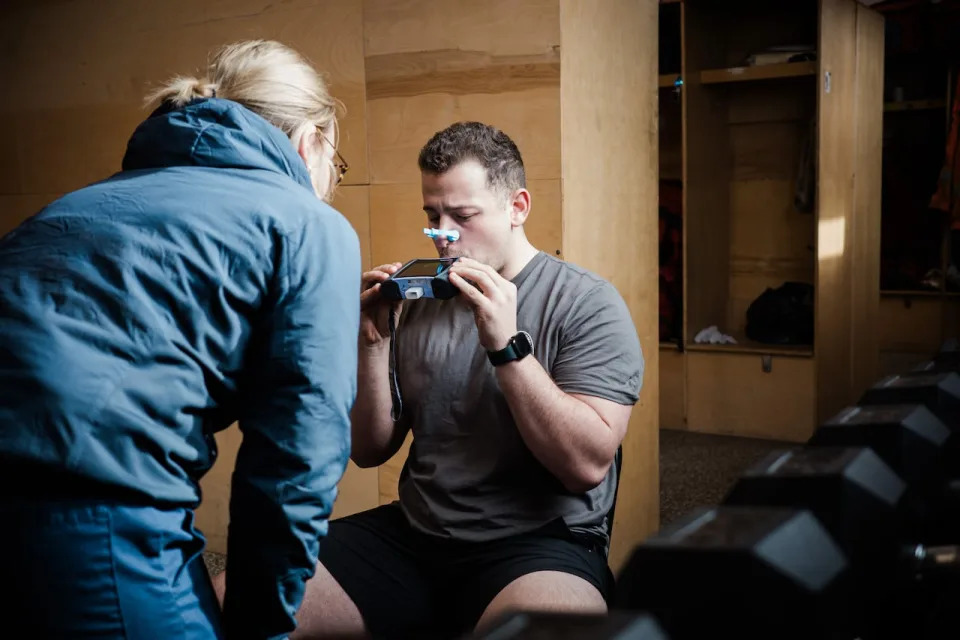CBC
Thu, April 11, 2024

BC Wildfire Service firefighters in Pemberton B.C. undergoing physical testing for researchers to collect pre-season data related to health and physiology. (Gian Paolo Mendoza/CBC - image credit)
After more than a decade of combating smoky wildfires in British Columbia, Kyler Gaulin says being on the front line has taken a toll on his body.
"It's a job we love ... but I notice, at the end of the season, my lungs are definitely not nearly as strong as at the start," the Pemberton, B.C., wildfire fighter said.
"We're working in a lot of very fine dust, a lot of smoke, a lot of ash."
In recent years devastating fires have burned in all corners of the province as thousands of firefighters inhale wildfire smoke with little protection. But new research aims to shed light on how those conditions are impacting firefighters' respiratory health.

A recruit works as part of an initial attack team tasked with containing and extinguishing an intentionally lit fire in a forest near Merrit on Thursday during a training exercise.
A recruit works to contain and put out a fire near Merritt, B.C., during a training exercise. Though hard hats and other gear are standard for wildfire fighters, respiratory protection is not. (Ben Nelms/CBC)
The B.C. Wildfire Services (BCWS), in collaboration with the University of British Columbia, is embarking on what they're considering "groundbreaking" research, looking at the respiratory health of wildland firefighters.
"We don't know a lot about how their vessels are reacting or not reacting to wildfire smoke," said Madden Brewster, postdoctoral research fellow at UBC's Okanagan campus.
Researchers will track firefighters' cardiorespiratory systems over the next two years collecting data before, during and after the fire season — something Brewster says "hasn't really been done before."
Many use nothing except bandanas to cover their noses and mouths, according to occupational hygienist Drew Lichty.
He says wildfire smoke contains a hazardous mixture of gases, pollutants and pieces of debris that are invisible to the naked eye.
"[Some] refer to it as a toxic soup of chemicals."
Such microscopic particles — which can be narrower than a strand of human hair — can find their way into the lungs and bloodstream, Lichty says.
WATCH | Researchers monitoring firefighter health through fire season:
In June 2022, the International Agency for Research on Cancer classified firefighting as a known human carcinogen, stating firefighters have a 14 per cent higher risk of dying from cancer than the general public. In Canada, more than 85 per cent of firefighter fatality claims are attributed to cancer.
Even amid mounting evidence that breathing smoke can cause deadly diseases, Lichty says right now, there's little to no research of the effects of wildfire smoke on the long-term health of wildland firefighters.
As the 2024 fire season begins, researchers are taking firefighters' blood samples and carrying out lung function tests to determine baseline measurements.

Wildland firefighter Emily Bennington wears an assortment of devices that will be used to collect data related to firefighter health and physiology this upcoming fire season in B.C.
Wildland firefighter Emily Bennington wears an assortment of devices that will be used to collect data related to firefighter health and physiology this upcoming fire season in B.C. (Gian Paolo Mendoza/CBC)
As the season progresses, Pemberton's wildland firefighters will be sent out into the fray equipped with air quality monitoring devices like gas detectors, which will measure carbon monoxide and air sampling pumps to detect particulates.
Gaulin, who is one of the research participants, says an in-depth look into the health of wildland firefighters is long overdue.
"These studies are super important obviously ... unfortunately, it's taken a couple busy years to get recognition of how serious the wildfires are becoming," he said.
Respiratory masks
As part of UBC's research, BCWS is also testing some masks, including multiple models of half-face dual cartridge respirators, which would enhance breathability and filter harmful particulates and gases.
Emily Bennington, a second-year initial attack firefighter, said the masks were "constrictive.
"I see the benefit of it, but I think practically, I would find it hard to work with."
Mike McCulley, procurement officer at BCWS, says finding the perfect mask for a wildland firefighter is tricky.
"If you picture a firefighter fighting a structure fire in a house, they have the luxury of being able to [carry] large masks, oxygen tanks. That's not the reality for wildland firefighters," he said, noting that they often work in difficult terrain.
"We are trying to make sure we're using the best [equipment]."
He says BCWS is procuring enough masks to outfit more than 1,600 firefighters it has employed this year, but they aren't mandatory.
The federal government says Canada is at risk of another devastating wildfire season, after an unusually warm winter. More than 70 fires are already burning across the country, primarily in northern B.C., northern Alberta and the Northwest Territories, officials said.
In the meantime, wildland firefighters Gaulin and Bennington hope the ongoing research will soon provide them with necessary insights to confront the unseen enemy threatening their heath and livelihood.
"I'm definitely excited to see how my health changes over a season, and my coworkers as well," Bennington said. "That would be very useful information to have."
No comments:
Post a Comment